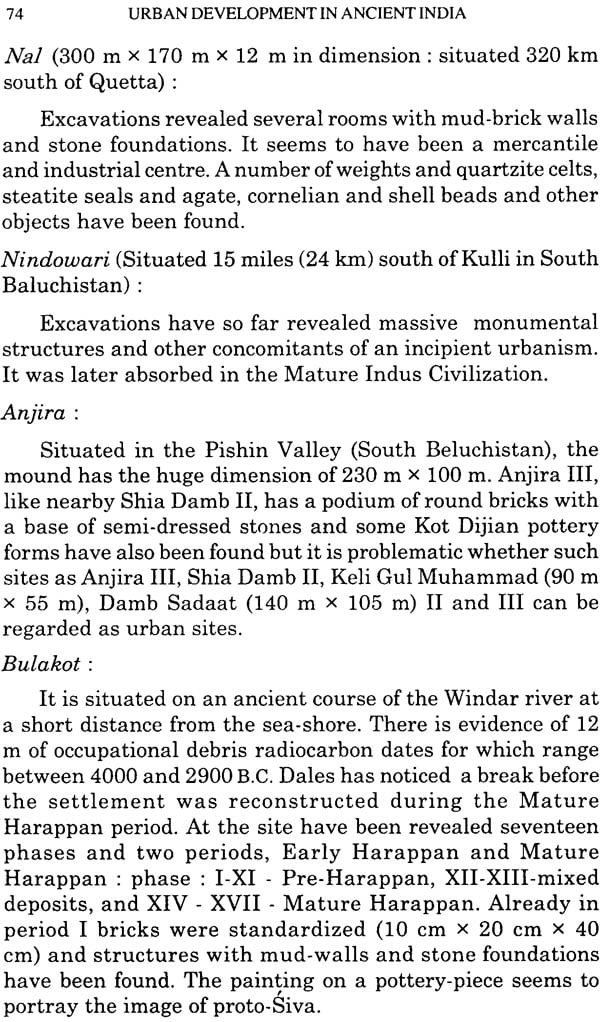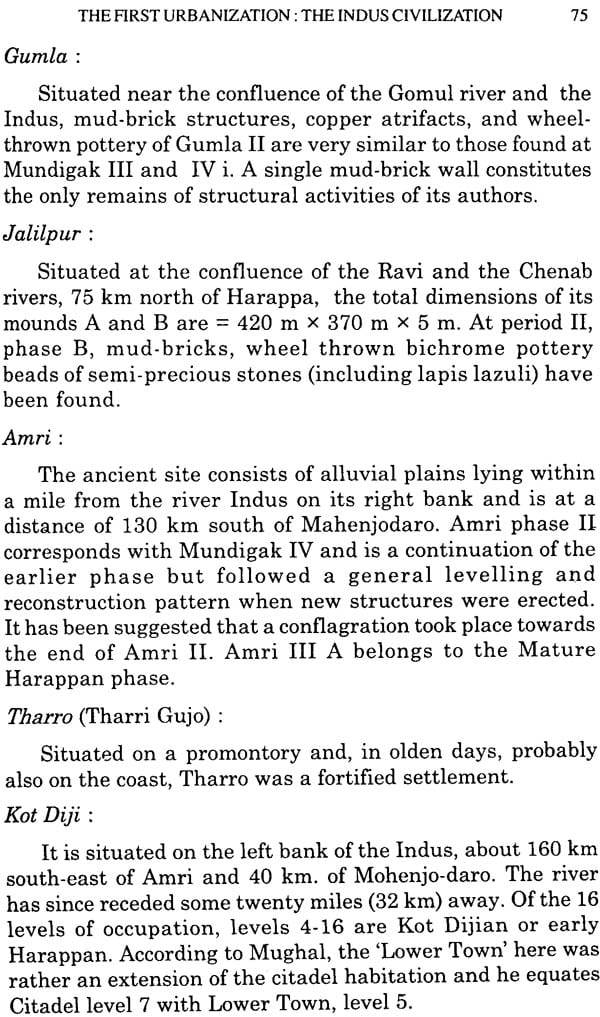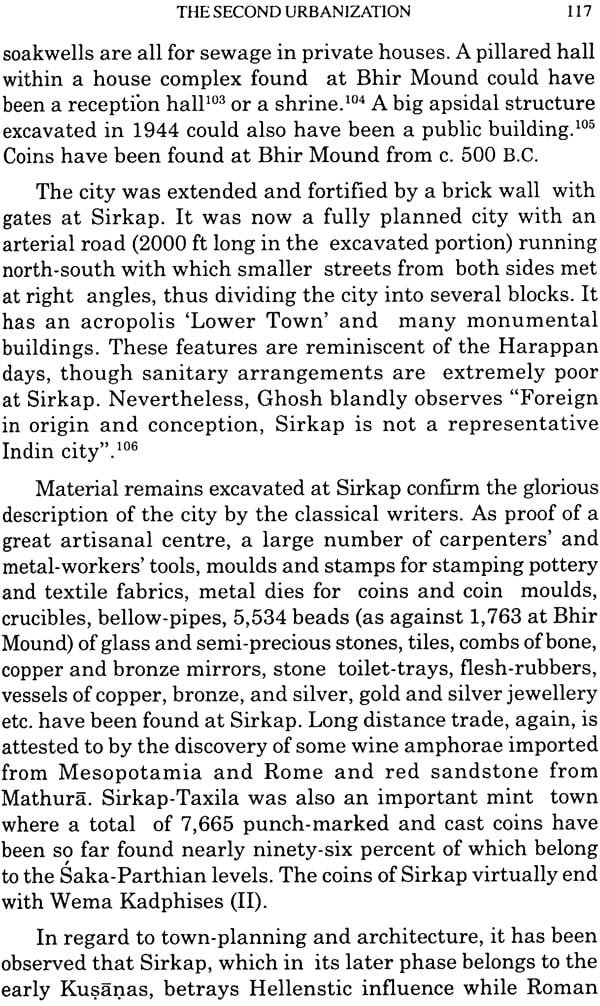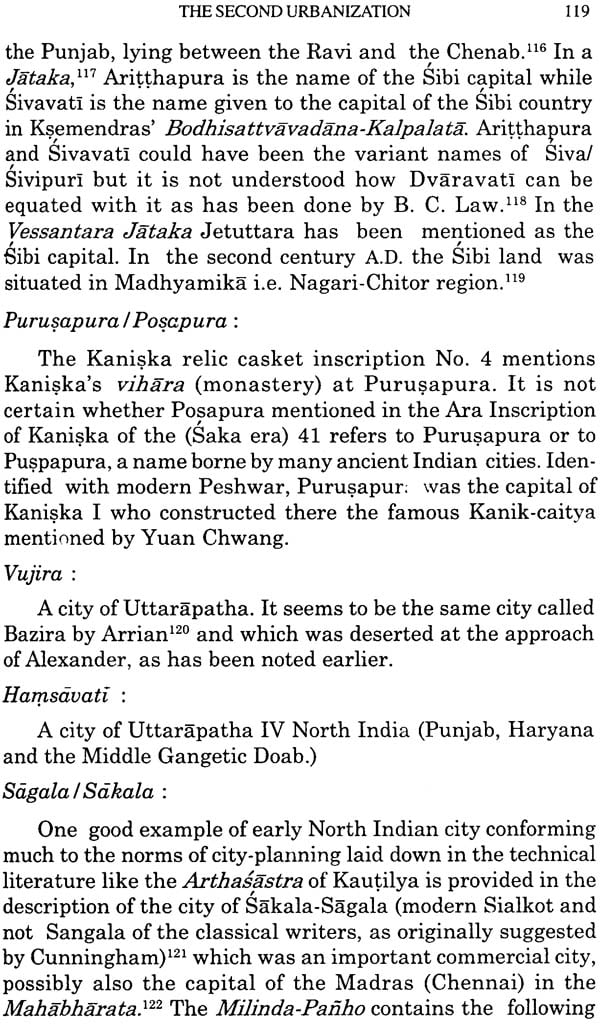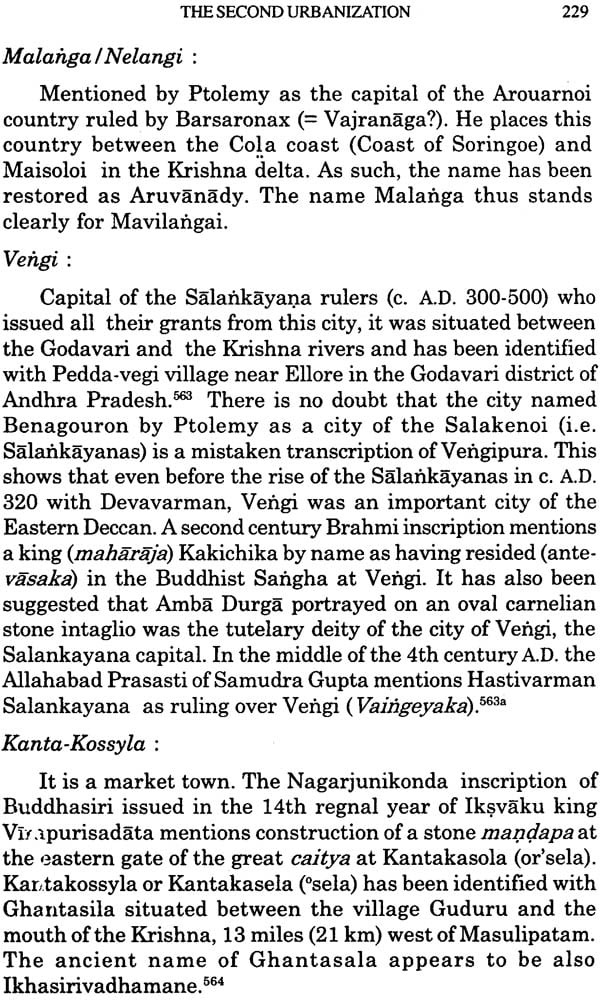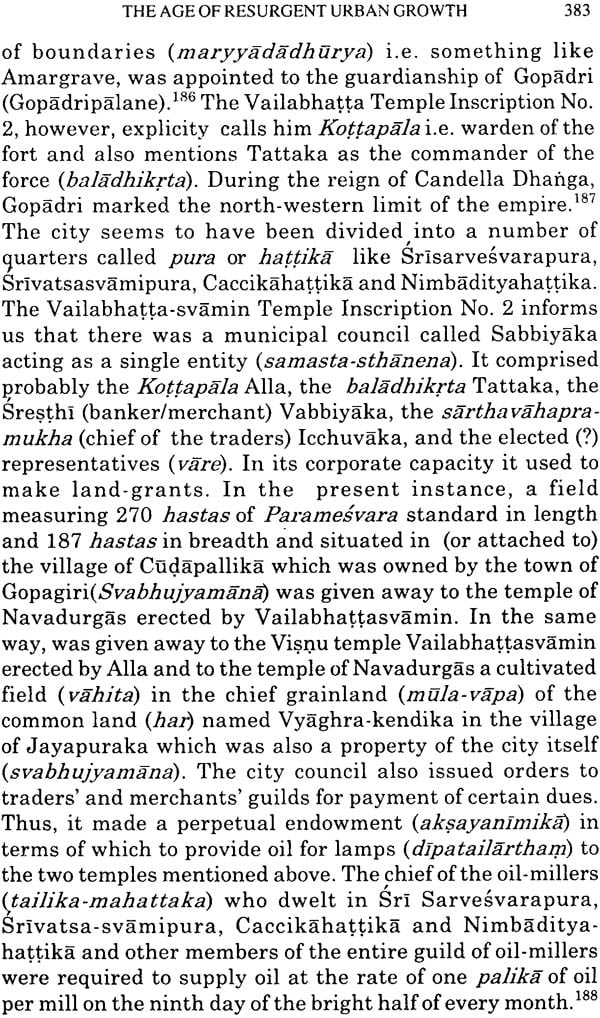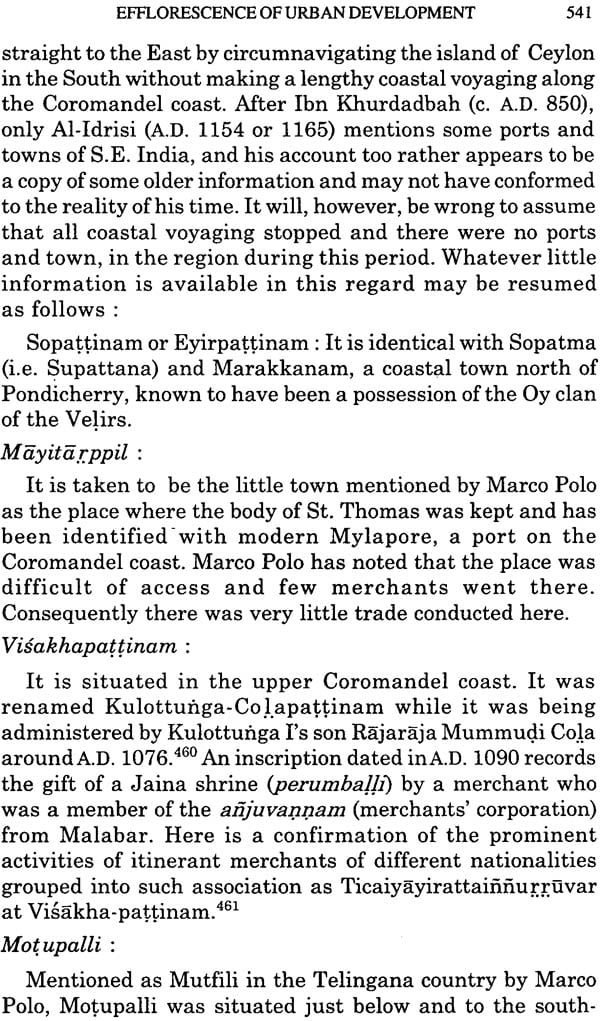
Urban Development in Ancient India
Book Specification
| Item Code: | NAG277 |
| Author: | Adhir Chakravarti |
| Publisher: | The Asiatic Society |
| Language: | English |
| Edition: | 2020 |
| ISBN: | 9788194529859 |
| Pages: | 612 |
| Cover: | PAPERBACK |
| Other Details | 8.5 inch X 5.5 inch |
| Weight | 790 gm |
Book Description
About the Book
In this book, the author traces the genesis and growth of urbanization in India over a vast time span-from Indus Civilization to 1250 A.D. It studies the different phases of urban development, their characteristics and intricacies and forcefully' argues against the theory of an urban decay in post-Gupta India on the basis of critical examination of a wide range of sources.
Starting with a meticulous introduction to the different literary sources, both indigenous and foreign, and the evidences of archaeological explorations, excavations, epigraphy and numismatics, the work outlines in detail the First and Second Urbanization in ancient India. It chronicles the changing pattern of urbanity from AD. 300 to 600, the resurgence of the phenomenon from AD. 600 to 1000, and its efflorescence from AD: 1000 to 1250 A.D. There is an incisive analysis of the factors that led to the growth of cities and towns, a comprehensive survey of the concept and classification of urban centres in Indian theoretical texts, and the network of trade and commerce, including the various ports and emporia, both coastal and interior.
Apart from exhaustive notes and bibliography, it has interesting appendices like 'Unidentified Cities and Towns mentioned only by Ptolemy' and 'A Note on Feudalism in India'.
About the Author
Born on April 24, 1932 at Kotalipara in Faridpur, now in Bangladesh, Adhir Chakravarti had his education at Chandraprabha Vidyapith of Pakshi in Pabna, Santiniketan and then at the University of Calcutta. After having his M.A. Degree, he worked as a Lecturer of the Surendranath College and the Asutosh College, Calcutta and then of the Krishnanagar Government College. In 1960 he joined the Government Sanskrit College as an Assistant Professor of Ancient Indian and World History. He went to the University of Sorbonne in Paris in 1964 and researched on Sanskrit and Khmer inscriptions of Cambodia under the supervision of Prof. George Coedes. Prof. Chakravarti became Professor of History of the Jhargram Raj College in 1973 and soon became the Principal of the institution. He served the Government of West Bengal in various administrative capacities and held the post of Director of Archives for many years. Later he joined the Bidhannagar Government College as. its Principal. His two-volume study of the Sdok Kak Thom Inscriptions shows the depth of his understanding of ancient Cambodian civilizations. Among his other works, besides numerous learned papers, Royal Succession in Ancient Cambodia is important. In fact, his premature demise on December 20, 1993 has incurred a devastating effect on future of Indian scholarship on South-East Asia in general and Cambodia in particular.
Foreword
The Asiatic Society presents to the discerning students of Ancient India Professor Adhir Chakravarti's Urban Development in Ancient India, which is replete with data and controversial issues. It is not just a work on historical geography. The author adduces in this book numberless data from a plethora of sources with a view to identifying and describing the multifarious processes involved in urban development in ancient India from very ancient times up to A.D. 1250. He does not support the view that the Gupta Age was economically decadent. Nor does he accept the view that feudalism developed during the Gupta Age. These subjects are highly controversial. Professor Adhir Chakravarti, however, presents his own conclusions and views in a lucid, but authoritative manner. The book would, we believe, be useful to both the specialist scholars and general students.
Preface
The present work is the outcome of two disputes, one absolutely personal and the other academic. While nothing has to be said of the former, the latter requires an explanation. With regard to urban development in India upto c. AD. 300, there is not much of controversy among scholars over material details. But a very forceful case has been made out in recent times to project the Gupta period not as a Golden Age but rather as one of decay and decline. It has also been pointed out that after the Imperial Guptas, there Was little political unity in India. Numerous petty states appeared instead in the stage of history. Land grants recording gifts of extensive pieces of land with all sorts of fiscal benefits, exemptions and immunities were issued in large number by rulers to individuals and religious establishments which in their turn made arrangements with other intermediaries who included craftsmen and artisans, all sorts of servants and agriculturists. Trade and commerce languished. Money as currency became rare in post-Gupta times. This state of decay was at first supposed to have contiuned till century A.D.1200 but now it is conceded that a rejuvenation came around A.D.1000.
In the present study an alternative point of view has been projected. There is little evidence of feudalism as a mode of economy. It is also not correct to say that production was never export-oriented or that export of certain commodities was not of common occurrence. Coined money as madium of exchange was also not as scarce or rare as has been imagined earlier. The argument of an urban decay in post-Gupta India on the basis of findings of archaeological excavations and explorations also does not appear to be very convincing. Finally, if Varahamihira and Yuan Chwang have mentioned the decline and decay of many old urban settlements and if many earlier cities and towns have not been mentioned by AI Biruni, all of them as also other Arab historians and geographers, have brought in names of many new urban centres which sprang up instead. Thus one is possibly entitled to speak more in terms of urban growth than decay in ancient India.
The author has an apology to offer. The present work concerns ancient India but it is very difficult to situate ancient India in point of both time and space. No absolute cut-out year can be stated as marking the close of ancient India and the beginning of the mediaeval period. Political and economic changes and developments in different parts of the country were uneven and took place at different times. This is why the date A.D. 1250 for closing this study is purely arbitrary and has been adopted for the sake of convenience to accommodate on the one hand the evidence of Chau Ku-fei (A.D. 1178) and Chao-Ju-kua (A.D_ 1225) and the bulk of the E)ila:ha:ra inscriptions. As for the territorial extent of ancient India, unlike in other directions, its north-western frontier has not remained constant. For our present purpose the political reality of each successive epoch has been accepted. Another methodological problem arises out of the uncertainty and confusion in determining (i) the time of occurrence of events and actualities described in some texts and (ii) the period preceding their composition or compilation in the present form. This has obliged us at times in making some otherwise avoidable repetitions and using the same evidences for different periods. Finally, as is well-known to all students of Indian history, materials available for study for all periods and regions are not uniformly copious and authentic. This basic insufficiency of source materials partly explains why the same geographical order of enumeration of the cities and towns could not be followed in all the chapters. It has also resulted in certain imbalances and lop-sidedness in the treatment of the subject for which one can only crave the indulgence of readers.
Introduction
A city can better be described than defined. It is a human settlement much larger in dimension and with greater density of population than rural areas. It was essentially non-agricultural even in pre-Industrial Revolution days and was dependent for its supply of food and raw materials for crafts and industries on a rich surplus-producing agrarian hinterland. It was, and still remains, a centre of production and distribution of craft and industrial goods. Artisanal production went hand in hand with trade and commerce. Thus, unlike the countryside, an important segment of the urban population comprised artisans, traders and merchants and bankers. Cities were, as a rule, more affluent than villages and concentration of honey, jewellery, and precious and semi-precious stones in the towns and cities made them covetable targets of enemy attacks. To ward off invasions by human enemies, depredations of wild animals, and havoc caused by flood urban centres had to be equipped with strong fortifications by constructing enclosure walls with gates, towers and battlemerts, moats and ramparts.
In the modern period, cities are more exclusively functional, that is to say, a city is essentially a centre of either commerce, industry, administration, education and culture or religion, but such specialization did not exist in ancient or even in mediaeval times. Nevertheless some cities served as capitals of states and headquarters of smaller administrative divisions, some were market towns and acted as entrepots, and still some others were important religious centres which attracted devotees and pilgrims from afar and were also famous as centres of learning. But, in most cases, the cities were at the same time centres of administration, trade and commerce, religion and higher education. In the ancient cities were therefore to be found, besides a ruling class represented by the king, nobility and soldiers, temple priests who also acted as teachers, and artisans, traders and merchants, and bankers, and, of course, some agriculturists.
Life-style was also different in the cities. Urbanity accorded greater refinement where with the pursuit of art and culture, literary activities, dance, music, drama and painting, architecture and sculpture flourished, and rural mores and customs, being more grotesque, become objects ofridicule. Excepting at the mercantile level where pedlars moved from urban centres to remote villages vending mostly goods of extremely localised production like metals, salt etc. and also some luxury goods, there was little interaction and communication between urban centres and the countryside. On the other hand, if in the cities as courtly members, priests, astrologers and ministers representing the Brahrnanical community should evince less antipathy for other city-dwellers, their mutual animosity is apparent in many respects. Even during the heady days of urban development in India in the centuries immediately preceding and following the Christian era, the authors of the Dharrna-sutras and Dharmasastras looked askance towards a city-dweller and his norms. Kautilya (Arthasastra II. 1) forbids entry of performing artists like actors, dancers, and musicians into the village. On the other hand, it is enjoined that a snataka Br ahrn ana should never enter a town (Apastamba Dharmasiitra. 1. 11. 32, 21). The Dharmasutras of Apastamba (I. 3.94), Gautama (xvi. 43) and Vasist. ha (XIII. 1) and finally the Mtuuive-dhermesestre (IV. 207) prescribe that there should be perpetual cessation i.e. non- study of the Vedic lore (anadhyaya) in the town. It has indeed been averred that a city-dweller can never attain salvation (Baudhayana Dh. Satrs H. 4, 6, 33). This kind of antipathy and animosity between the countryside and urban centres is nothing special to India. It has been observed that, "between the urban life in the city and the provincial life outside the city, there has always been a gulf of mistrust, suspicion and contempt."
Apart from this basic dislike of urban centres, in a country like India where through the ages the prop of the economy has been overwhelmingly agricultural, it is only natural to expect that there will not be too many notices, let alone glorification, of towns in literature, both secular and religious. Indigenous secular literature like the Kavyas is mostly concerned with the royalty and the court nobility and does not take much interest in the mundane affairs of everyday life. This is why even when cities and towns are mentioned in literature, their descriptions are highly conventional and stereotyped and, as such, can hardly be accepted as reflection of the reality. It is interesting to note that, often in the Jaina literature after the mention of a large town occurs the word vamsku which is a rough and ready conventional description of a city, its fortifications, gates, towns, streets, mansions and palaces, parks, groves and lakes etc.?
There are, however, some theoretical texts on political economy like Kautilya's Artheesstrs and treatises on architecture like the Manasara and Mayamata. The Arthessstre has indeed a section on construction of forts in which very elaborate description is given of the lay-out of the royal fort (durga) i.e. the capital city. But this is a prescriptive text and it is not known whether any city was ever planned and laid out according to its norms. The details of the different categories of towns and cities and fortified places described in the two other texts referred to above are highly interesting and will be discussed in some details later on in the course of the present study. But to what extent their accounts may be accepted as historically true cannot be vouchsafed, though the treatises are indicative of some real urban development at the time of their composition and/or compilation.
The latter part of the above statement brings us to the one great problem in utilising literary evidence for an understanding of urban development. Very few ancient Indian texts have been successfully or even approximatingly stratified vertically i.e. in point of time or horizontally in point of space. Further, in many cases it cannot be ascertained as to whether the description, say of a particular town or city, in a text applies to the approximate time of composition of the original text or of its compilation in its present form. Thus, the description of 'I'anra lip ti as a· flourishing city in the Samaraiccha-kaha of Haribhadra-suri, a work of the ninth or tenth century AD. or in the Ketbsssritsagsrs of Ksemendra (12th century AD.) is surely not true since there are various other indications, both literary and epigraphic, to show that 'I'am ralipti as a sea-port town ceased to exist sometime about the eighth century AD.
The greatest merit of the accounts left by foreign travellers and pilgrims, geographers and historians is their contemporaneity with the condition described. The accounts of the classical writers beginning with Alexander's historians are of immense value for writing a history of urban development in ancient India for the added reason that the Greeks particularly could not make any mistake in recognizing a town and distinguishing it from the country settlements. It thus becomes incumbent for an historian to explain the material conditions which favoured the growth and sustenance of hundreds of cities and towns in the Indus valley and adjoining regions of Bind and the Punjab in the fourth century B.c. The Periplus of the Erythraean Sea, a work composed around AD. 80 by an unknown Alexandrian sailor, 3 contains a unique description of the commercial and mercantile activities of the western seaboard of India as far south as Corn ore (Cape Comorin) and Bacare (on the Coromandal coast). His description of the eastern seabord of India is unfortunately not very informative. An extremely comprehensive account of the market towns and emporia, interior cities and metropolises is contained in Ptolemy's Geography (c. A.D. 140). Like the classical accounts, there are also memoirs left by the Chinese. From the beginning of the fifth to the end of the seventh centuries AD. a number of Chinese pilgrim-scholars like Fa-hsien, Yuan Chwang, I-tsing, Wu-kong and others visited India. Some two centuries later, from AD. 851 onward, a number of Arab historians and geographers wrote about India in their accounts. Most prominent among these are the so-called account of the merchant Suleiman with a supplement by Abn Zaydstraft," the Account of Routes and Provinces by .Abtt Khurdadbah (A.D. 906),5 Meadows of Gold by Al-Masudt," Accounts of India by Al-Biruni (AD. 1030)7 and Geographical Dictionary by Al-Idrtsi (AD. 1154). There are also some others like Ibn Hauqal and Al-Istakhri" who need also to be mentioned. But later Arab writers mostly repeat all that has been told by their predecessors. In the 13th and 14th centuries, Marco Polo and Ibn Battuta furnish some new information about ports, cities and commercial and political centres of India. The Chinese works viz. Ling-wai-tai-ta of Chau ku-fei (A.D. 1178) and Chu fan-chi of Chao Ju-kua (A.D. 1225) are important sources of information for reconstructing the commercial and urban history, particularly of Southern India which can be very well elucidated and supplemented by the accounts of such later Chinese accounts as Wang Ta yuan's Tao i chih lio (AD. 1349), and the accounts of the seven voyages of the great Chinese captain Cheng-ho (A.D. 1407-14) left by Ma-huan and Fei-hsin. P But these latter works fall strictly beyond. the scope of the present work.
Contents
| Foreword | v |
| Preface | vii |
| Acknowledgements | ix |
| Abbreviations | xi |
| Introduction | 1 |
| Chapter I |
|
| THE FIRST URBANIZATION: THE INDUS CIVILIZATION | 72 |
| Chapter II |
|
| THE SECOND URBANIZATION | 97 |
| Chapter III |
|
| THE CHANGING PATTERN OF URBAN DEVELOPMENT (A.D. 300-600) | 271 |
| Chapter IV | |
| THE AGE OF RESURGENT URBAN GROWTH (A.D. 600-1000) | 331 |
| Chapter V |
|
| EFFLORESCENCE OF URBAN DEVELOPMENT (A.D. 1000-1250) | 449 |
| BIBLIOGRAPHY | 570 |


